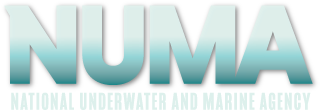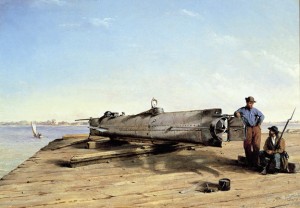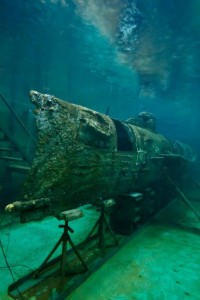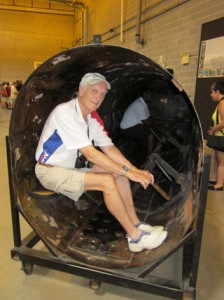H.L Hunley: ‘Gotta See it!
When the chase ended, the adventure author and shipwreck seeker followed through as always…he turned his find over to the state. Now, South Carolina, through an agreement with the U.S. Navy, houses the Hunley in a spacious building at the Warren Lasch Conservation Center in the old Charleston Navy Yard. The museum, open only on weekends, is located at 1250 Supply St., about a 20 minute drive from downtown Charleston. In my book, it’s not a bucket list attraction. It’s an event and you ‘gotta see it ASAP!
My wife, Cathy, and I accompanied by a dozen other visitors and our guide, Bill Billingley, climbed the steps in the tank room to the platform that affords a birds-eye view of the first submarine to sink an enemy warship. “Amazing, absolutely amazing,” was all I could think as I pictured eight sailors jammed into this sardine can that was to take on the Housatonic, a Union sloop-of-war that sported 12 cannons. Sitting in a custom-built tank filled with crystal clear fresh water that’s monitored daily for ph, temperature, chlorides and oxygen, the small boat appears vulnerable. Yet the metal remains dense and will maintain its strength as the salt is leached out in the continuing stabilization process. Several sections of the upper hull plates were removed by drilling out the rivets. This allowed scientists to study the contents and visitors to see the hand cranks and heavy iron crank shaft that turned the propeller.
As part of his imaginative insight, inventor Horace Lawson Hunley—for whom the sub was named—designed a 22-foot-long iron spar that acted as the boat’s torpedo. Mounted on the bow, it had a barbed point and a canister filled with 135 lbs. of black powder. On February 17, 1864, the attack was successful as the barb found its mark and the powder did its job. The Housatonic sank within minutes of the explosion.The Hunley, discovered outside the entrance to Charleston Harbor—not far from the encounter—never surfaced. The crew’s bodies were found at their duty stations, suggesting there was no emergency prompting a scramble to escape. Although it remains a cold case, one theory is they died from anoxia: oxygen deprivation which can happen fast in a confined space. Although the heroes never returned to get their accolades, they received an honorable burial.
Throughout the museum, many of the sailors’ belongings bring back fond memories in nostalgic displays. Most fascinating are the possessions of the sub’s captain, Lt. George Dixon. Found between two layers of cloth were a diamond ring and brooch, his pocket watch and a bent $20 gold piece that might have saved his life. Research reveals the coin was given to him as a good luck piece by his Alabama sweetheart, Queenie Bennett. Dixon kept it in his pocket where it deflected a Yankee bullet that could have killed him when he fought at the Battle of Shiloh. One side of the coin portrays an image of Lady Liberty while the flip side features a federal shield and an eagle. Part of this was sanded away and inscribed: “Shiloh, April 6, 1862, My Life Preserver, G.E.D.”
Visitors could spend the good part of a day perusing all the exhibits, while taking an intermission to catch two films about the Hunley. Literally thousands of artifacts were retrieved from the sub: buttons, bottles, pins, pipes, thimbles, coins lucky charms and more. It was common in those days for sailors to carry a lucky piece, Dixon’s gold coin being a prime example.
I experienced a prime example of hard work when I boarded a mock-up of the sub on display in the large hall. Perched on one of the crew’s hard wooden benches, I used two hands with a strong grip to turn the crank that that was used to spin the propeller. I discovered in short order what a labor intensive task it was in cramped quarters where candles provided the only available light.
Graphics cover the museum walls depicting the origin of the sub, its construction and a bio of its inventor. Storyboards analyze the skeletal remains that were recovered and the archaeological investigations still being conducted today. Audios describe the restoration process and intricate plans that led to the raising of the Hunley in August, 2000. Children love the interactive exhibit where they climb down into a Hunley mockup as if they’re preparing to go to sea.
A glass case unfurls Harry Pecorelli’s dive suit. He was the first person to touch the first successful attack submarine that sank over 100 years ago. In August, 2000, Pecorelli—an archaeologist as well as a diver on the project for several years– was on board a boat near the wreck site, celebrating the raising of the vessel. Accompanied by his discovery team members Ralph Wilbanks and Wes Hall, he was amazed at the hundreds of pleasure boaters and media reps that watched and waited for the recovery.Meanwhile, Cussler was aboard one of the press boats and as the Hunley came up he spotted his buddies, leaped into the water fully clothed and swam over to join them. When asked about it later, the famous writer with a wry grin mused, “There’s life in the old dog yet!” A chorus of fog horns and cheers arose when the barge’s crane brought its prize to the surface.
Later, studies revealed the Hunley incorporated much of the technology used in our modern-day submarines including: ballast tanks, planes and forward and aft conning towers. The little sub didn’t receive much publicity over the years until it was discovered and raised. That’s when people realized how much it changed the course of naval history.
For further information or to make a contribution for further research and restoration, contact Raegan Quinn at the non-profit group: www.hunley.org.
7 Comments
Submit a Comment
All Rights Reserved © | National Underwater and Marine Agency
All Rights Reserved © | National Underwater and Marine Agency
Web Design by Floyd Dog Design
Web Design by Floyd Dog Design




Dear Mr. Boyd,
This article I would rate as one of your “top ten”……interesting, factual, and well-written. I have to confess that I’m a fan of your articles and I eagerly await the next one. Thanks for keeping us informed about these interesting and exciting wrecks!
Dr. Robert J. Shockley
There is nothing, in my opinion, better than sitting down and reading an article that gets the juices flowing like this one has. Fascinating and informative Professor. Sorry to have dropped off the map for so long I will send you pictures of the Maritime Fest at the Foss Museum on the 24th & 25th. We will be firing the 3 inch bore, 500 pound Nisqually Carronade off the dock at hourly intervals on the first day.
Ethan Allen
Thank you so much. I appreciate your kind words. I truly believe that anyone interested in the Civil War, shipwrecks, or history in general should try to make plans to visit the museum and see the submarine resting in its fresh water bath. The story really comes to life as the guide relates it and gives an update on the current preservation strategy. Thanks again. E. B.
What an interesting article. I didn’t realize the Hunley was being preserved in a museum in Charleston. I am planning a trip to Charleston in the fall and I will be sure to see it. Thanks for the heads up.
Question actually. Are anymore of the Numa files going to become movies. I loved reading your books but my eyesight is not good enough for reading anymore
I watch Sahara so often I need a new copy
The main reason I like your writing is after I read one I have a difficult time convincingly brain that It wasn’t a movie. I only know one other author that writes like that. Thank you for your stories
Would like to buy a magazine about ships that you found,history of ships,marine archeology on sunken ships.
Somehow, a question sent in by Bill Schultz ended up in my article about Dale Clifton. Bill asks where he might find a model of the Housatonic. It’s hard to say, but I would start by calling and or writing to the Mariner’s Museum: Mariner’s Museum, 100 Museum Dr., Newport News, VA 23606. The phone number is: (757) 596-2222
And, I don’t know if this is possible, but if e-bay had a “searching for” page, that would get the question out to lots of people. I